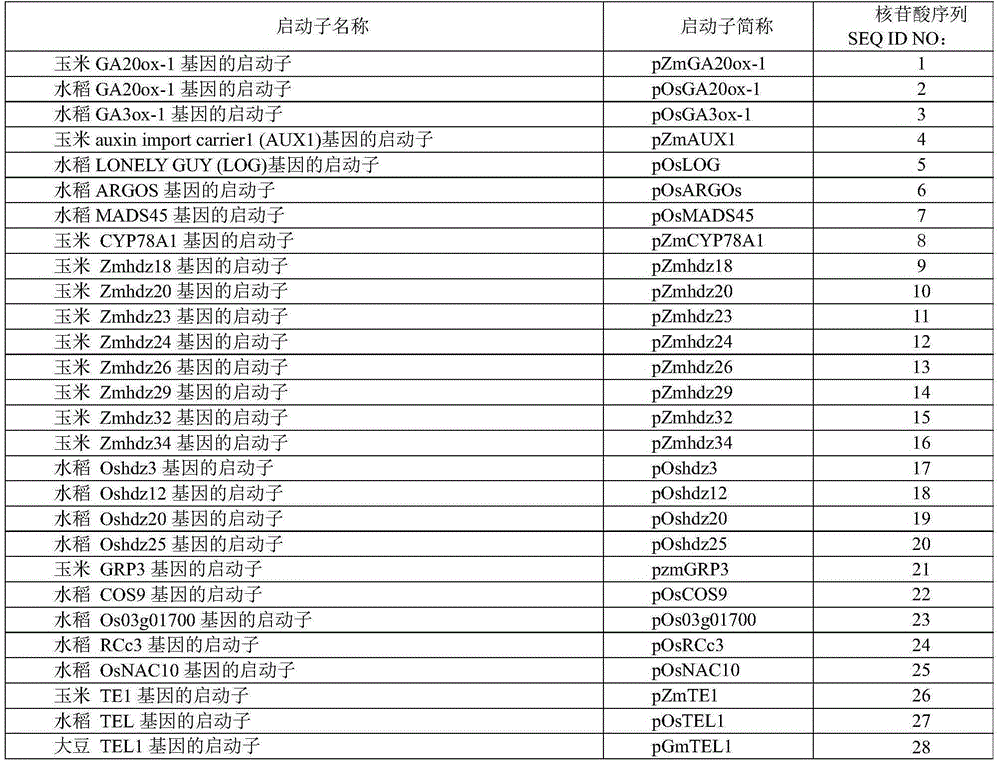Application of tissue-specific promoter to regulation and control of crop yield
A tissue-specific, promoter technology, applied in the field of plant genetic engineering, can solve the problems of incompatible plant type, high plant height, and plant sterility.
- Summary
- Abstract
- Description
- Claims
- Application Information
AI Technical Summary
Problems solved by technology
Method used
Image
Examples
Embodiment 1
[0042] Example 1. Cloning of tissue-specific promoters
[0043] 1. Cloning of reproductive tissue-specific promoters
[0044] Obtaining the ZmGA20ox1 promoter (pZmGA20ox1) of maize (Zea mays) gibberellin synthase gene: Design PCR primers pZmGA20ox1-F (5'TAAGCTTCTGCCATGACGTGATTGTCCCTGGC) and pZmGA20ox 1-R (5'GGGATCCAGGAGGGAGGAAGCAGAGGAGGAG) to the genome of commercial maize variety Zhengdan 958 As a template, pZmGA20ox1 was obtained by PCR amplification. The PCR reaction conditions were: 95°C for 3 minutes; 95°C for 15 seconds, 58°C for 15 seconds, 72°C for 2 minutes, repeating 30 cycles; and then 72°C for 10 minutes. The obtained PCR product of approximately 2 kb was cloned into the T-vector pMD19. Then, the corresponding promoter pZmGA20ox1 was obtained by double digestion with HindIII and BamHI, and DNA sequence determination showed that the nucleotide sequence of the promoter was correct (SEQ ID NO: 1).
[0045] Cloning of OsGA20ox1 promoter (pOsGA20ox1), a key enzyme ge...
Embodiment 2
[0068] Cloning of embodiment 2.TEL gene
[0069] Cloning of TE1 gene cDNA in maize (Zea mays): PCR primers ZmTE1-F (5'GAGGATCCAACAGAATTCATGGGTGGGTTC) and ZmTE1-R (5'GCGGTCTAGATTACTAGTCGTCGTAGCCAAGC) were designed and amplified by PCR using the total cDNA of commercial maize variety Zhengdan 958 as a template The cDNA fragment of TE1 is about 2 kb in size. The PCR reaction conditions are: 95°C for 3 minutes; 95°C for 15 seconds, 58°C for 15 seconds, 72°C for 2 minutes, repeating 33 cycles; 72°C for 10 minutes. The obtained PCR product of approximately 2 kb was cloned into the T-vector pMD19. Then, ZmTE1 was obtained by double digestion with BamHI and XbaI, and DNA sequence determination showed that its nucleotide sequence was correct (SEQ ID NO: 29). Afterwards, the cDNA obtained by enzyme digestion and the synthetic terminator ter1 (nucleotide sequence is SEQ ID NO: 33) are connected by XbaI to obtain a nucleotide sequence with a structure of (BamHI)ZmTE1-ter1(KpnI) for use ...
Embodiment 3
[0072] Example 3. Construction of the expression vector of the TEL gene regulated by the tissue-specific promoter
[0073] The binary vector pCambia1300-G10 vector (Internationl Pat.No.PCT / CN2012 / 087069:SEQ ID NO.49) contains a glyphosate-tolerant gene (EPSPS) (as a marker gene for transformation) and the Multiple cloning sites.
[0074] The tissue-specific promoter cloned in Example 1 and the TEL gene cloned in Example 2 can be connected through BamHI and BamHI, or isozyme BamHI and BglII to form a "tissue-specific promoter-TEL gene-terminator -pZmUbi-EPSPS-terminator" ( figure 1 ), the T-DNA vector obtained by the above method is shown in Table 2.
[0075] Table 2: T-DNA vectors composed of tissue-specific promoters and TEL genes
[0076] Promoter Gene T-DNA vector name pZmGA20ox-1 ZmTE1 pCambia1300-pZmGA20ox-1-ZmTE1-pZmUbi-1174 pZmAUX1 ZmTE1 pCambia1300-pZmAUX1-ZmTE1-pZmUbi-1174 pOsARGOs ZmTE1 pCambia1300-pOsARGOs-ZmTE1-pZmUbi-117...
PUM
 Login to View More
Login to View More Abstract
Description
Claims
Application Information
 Login to View More
Login to View More - R&D
- Intellectual Property
- Life Sciences
- Materials
- Tech Scout
- Unparalleled Data Quality
- Higher Quality Content
- 60% Fewer Hallucinations
Browse by: Latest US Patents, China's latest patents, Technical Efficacy Thesaurus, Application Domain, Technology Topic, Popular Technical Reports.
© 2025 PatSnap. All rights reserved.Legal|Privacy policy|Modern Slavery Act Transparency Statement|Sitemap|About US| Contact US: help@patsnap.com



